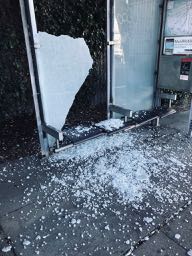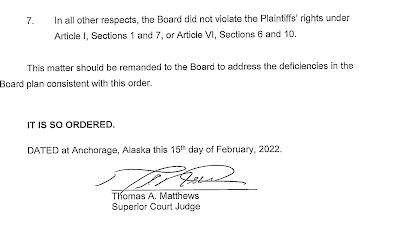I imagine the judge up late last night, writing, then stopping to look things up in the materials the attorneys submitted, in the transcripts of the Board meetings, in Hickel v Southeast Conference, and other Supreme Court rulings on redistricting. He's busily reviewing what he's written, having staff check for typos, and generally giving himself as much time as he can, so he can get it as right and as inclusive as possible.
Fortunately, blog posts aren't as consequential. But I can't help thinking about the factors Judge Matthews has to balance. While compactness, contiguity, deviation, all count, I think that the interpretation of Socio-Economic Integration (SEI) will be the most critical. But issues about public participation and gerrymandering will also be in the mix.
So here's a look at the cases being decided and another look aback at the Hickel case.
That case was decided December 29, 1992. (Not to be confused with a 1994 case with the same name which settled payment of attorney fees on the original case.)
At that time redistricting was done by the Governor. A 1998 Constitutional Amendment gave the process to a Board of five. The Governor chooses two members and the Speaker of the House, Senate President, and Supreme Court Chief Justice each choose two, "without regard to political affiliation."
I add that last note because the Governor clearly used political affiliation in his choices. Board member Budd Simpson said as much when questioned by Skagway attorney Robin Brena. Those choices were clearly unconstitutional, but whether the courts take that into consideration remains to be seen. While there were situations where incumbents of the same party were paired or other instances where decisions were made that will have partisan impacts, those weren't direct targets of lawsuits. However, the East Anchorage attorney has charged that the Eagle River pairings were done to give (very Republican) Eagle River an extra Senate seat, so this is on the record for the judges to use if they see fit.
But the critical issue as I said in all of the cases boils down to the meaning of Socio-Economic Integration (SEI), one of the four key criteria for evaluating the constitutionality of a district. The other three are
- equal sized districts
- compactness
- contiguity
§ 6. District Boundaries
The Redistricting Board shall establish the size and area of house districts, subject to the limitations of this article. Each house district shall be formed of contiguous and compact territory containing as nearly as practicable a relatively integrated socio-economic area. Each shall contain a population as near as practicable to the quotient obtained by dividing the population of the state by forty. Each senate district shall be composed as near as practicable of two contiguous house districts. Consideration may be given to local government boundaries. Drainage and other geographic features shall be used in describing boundaries wherever possible.
The key guidelines the Board's attorney, Matt Singer, has used for SEI has been: Everything within a borough is SEI. And that was said clearly
"Everything within a borough or city boundary is SEI."
Therefore, according to Singer, talking about SEI within Anchorage is besides the point. He even cited the Supreme Court as saying at one point that Mat-Su and Anchorage could be combined and so he stretched that, at times, to claim all of Mat-Su and Anchorage are SEI. He backpedaled on that during the mapping, but he even claimed, in the closing argument (if I recall right) that at one time the court had allowed Valdez to connect to Anchorage, and since all three shop in Anchorage and use the Anchorage Airport, they can all three be considered SEI.
My lay reading of the Hickel case and the Constitution make me believe Singer's interpretation is much more simplistic than the Supreme Court's. Valdez and Skagway attorney also sees it differently.
The Constitution says "as near as practicable a relatively socio-economic area." Each criterion is qualified with "as near as practicable" because they all have to be balanced to form each district and then to put all forty districts together. As you get closer to the ideal in one criterion, you get further away in others.
In the Hickel case, PART II: LEGISLATIVE REAPPORTIONMENT begins with this quote from the Alaska Constitutional Convention:
"Now the goal of all apportionment plans is simple: the goal is adequate and true representation by the people in their elected legislature, true, just, and fair representation. And in deciding and in weighing this plan, never lose sight of that goal, and keep it foremost in your mind; and the details that we will present are merely the details of achieving true representation, which, of course, is the very cornerstone of a democratic government."
3 Proceedings of the Constitutional Convention (PACC) 1835 (January 11, 1956). [1835 is the page number]
This seems to make it pretty clear that 'the details' are a means to an end. So, what does that mean?
Hickel then says the various criteria - size, compactness, contiguity, and SEI - have to be fit together. That's the hard part, but they help constrain the Governor (at that time) from gerrymandering. They give several definitions of gerrymandering, but the essence seems to be
Gerrymandering is the dividing of an area into political units "in an unnatural way with the purpose of bestowing advantages on some and thus disadvantaging others."
"Gerrymandering is `the deliberate and arbitrary distortion of district boundaries and populations for partisan or personal political purposes. , ,'"
While people often think of gerrymandering as being directly related to giving advantage to one party over another, these definitions cited in the Hickel case are broader than that. They include "partisan" [that would be political party] or 'personal political purposes'. [that would mean more for personal power advantage.]
They then tell us that limiting SEI can only be done to increase compactness and contiguity, NOT to achieve some other goals.
The requirement of relative socio-economic integration is given some flexibility by the constitution since districts need be integrated only "as nearly as practicable." Alaska Const. art. VI, § 6. However, the flexibility that this clause provides should be used only to maximize the other constitutional requirements of contiguity and compactness. The governor is not permitted to diminish the degree of socio-economic integration in order to achieve other policy goals.
There's a lot more discussion, but one more quote on SEI from Hickel:
"Relatively" means that we compare proposed districts to other previously existing and proposed districts as well as principal alternative districts to determine if socio-economic links are sufficient. "Relatively" does not mean "minimally," and it does not weaken the constitutional requirement of integration.
Skagway Case
ASIDE TO READERS: You can see how hard it is to separate one concept from another. I'm trying to talk about SEI, but all these other factors are intimately related. In the case of Skagway, attorney Brena has argued with lots of supportive data, that Skagway is significantly more SEI with downtown Juneau (with which it is currently paired in a district) than it is with the Mendenhall Valley (in the Juneau Borough) where Board member Simpson put Skagway in the new maps. Singer is using "Everything in a Borough is SEI" to say that it doesn't matter, constitutionally, if Skagway is with Mendenhall Valley or with downtown Juneau.
Brena has argued that it does matter. He's also arguing, without saying it out loud, that there is gerrymandering going on. He's given the court all the pieces to put together:
1. Simpson was picked because he's a Republican
2. He and his wife have been strong supporters of building a road to Skagway from Juneau
3. He's given election results to show that Mendenhall Valley favors the road and downtown Juneau doesn't
4. He's offered evidence that a road would devastate Skagway's economy as the 'Gateway to the Klondike" and as a cruise ship destination (the source of over 90% of their income). [Maybe it would, or maybe there would be new opportunities, but they seem to believe it would.]
5. He's shown public testimony being overwhelmingly in favor of Skagway staying with downtown Juneau and not splitting up the Mendenhall Valley. (Another complication because I haven't cited above the part of the constitution that says the board needs to spend six weeks getting feedback from the public on their draft plan. So what the public thinks matters, but the Board's attorney brushed it off with "This isn't a popularity contest.")
So Brena, all together, is giving the Court the pieces to see that Simpson ignored the close SEI ties between downtown Juneau and Skagway to put them into a district they aren't so SEI with. This will mean their "adequate and true representation" will be diluted by having a representative who represents mostly people who want to build the road to Skagway, which they strongly oppose. And Simpson did this, ignoring public opinion, to further his personal political purpose of building the road to Skagway.
So, the court has to balance Singer's mantra of "everyone in a Borough is SEI" with all these other factors that Brena says need to be considered.
So it seems that in trying to provide legal perspectives on SEI, I've essentially laid you Robin Brena's case for why Skagway should be with downtown Juneau. I'd also note, this is the easiest case to fix. No other districts need to be affected. Just move the line south to add about 4000 people and reunite the Mendenhall Valley community. Then take out Skagway, Haines, and Gustavus - also close to 4000 - and put them with downtown Juneau.
East Anchorage Case
Issues here: Compactness, Contiguity, and Socio-Economic Integration. Also some hints at
gerrymandering.
1. Contiguity is a possible big issue here, so let's see what Hickel said (in part, of course)
"Contiguous territory is territory which is bordering or touching. As one commentator has noted, "[a] district may be defined as contiguous if every part of the district is reachable from every other part without crossing the district boundary (i.e., the district is not divided into two or more discrete pieces)."
The Board's interactive map makes the two Eagle River districts D22 and D24 purple so you can't really see which is which. But they're paired with Elmendorf/Govt Hill (D23) and that little orange almost rectangle in the middle left (D21). From Government Hill you'd have to drive through two districts to get to the other district in your Senate pairing. From you South Muldoon you'd have to do the same. Not contiguous in that sense. Unless you want to hike over a mountain range.
The Eagle River district maps only show parts of the districts. It's hard to figure how they fit into this map above.
East Anchorage is about the pairing of Senate districts and the only factor mentioned in the Constitution is contiguity.
The two house districts paired here are contiguous geographically. There is a large part where both districts touch. But it is roadless land - mountains and different river drainages. To get from the South Muldoon district to the Eagle River district you have to drive out of the district through other districts about eight or ten miles.
The courts allowance of contiguity via roadless areas was originally in recognition that the State has many communities off the road system. So that makes sense in rural areas. It doesn't making sense in urban districts. (Urban districts are also expected to have lover deviations (from the ideal population) than rural districts.
2. Socio-Economic Integrity
The two Eagle River districts which adjoin each other like the two halves of an apple (a very odd shaped apple) are among the whitest and wealthiest districts in Alaska. The homes are large and many on large secluded lots. The south Muldoon district is has a population made up of a large percentage of people of color and immigrants - actual population is close to 50%, voter age population is lower. When a Muldoon house district was paired with an Eagle River district in 2013, the State's only black Senator was trounced in the next election.
So the goal of reapportionment, from the Constitutional Convention of "adequate and true representation by the people in their elected legislature, true, just, and fair representation" is what the Court should be considering closely, because the people of south Muldoon are not going to get fair representation in the Senate with this pairing. Continuity and compactness were also sacrificed to form this and the other Eagle River district that goes to Government Hill and parts of downtown.
Gerrymandering is also an issue here. Board member Marcum said at the Board meeting that this pairing would give (Republican) Eagle River an extra Senate seat.
Putting the two Eagle River house districts into one Senate seat is the most obvious and natural pairing on all factors, for both Eagle River and the two Anchorage districts they were paired with. It would require repairing [pair them with different house districts*] some of the north Anchorage bowl house districts, but wouldn't be difficult and wouldn't affect other parts of the State.
*Someone was confused with 'repairing' thinking I meant to fix, but I meant to re-pair them with other districts.
Calista
I have much less sense of this case. Essentially, there are enough Calista Native Corporation members for one and a half house districts and about 70% of a Senate district. The Board's map spreads them out over three house districts (D37, D38, D39) and two Senate districts. They didn't come up with a map that puts all their members in two districts, but they did, if I understand this right, manage to increase their percentage in the third district from 1% to 10% (or something like that.)
From Calista's Findings of Facts and Conclusions of Law:
"Calista’s goal was to achieve more effective representation for its region by consolidating more of its population into fewer districts, specifically by having Hooper Bay, Scammon Bay, and Chevak—which were historically in a district with Nome (District 39)—moved into the Bethel district (District 38), and shifting other Calista villages into the district to the south (District 37). While the Calista Region would still be split across three house districts and two senate districts, this would concentrate more of the region’s population into two house districts and one senate district in a manner that would have a meaningful effect on future election outcomes." [emphasis added]
The goal, according the Calista President and CEO Andrew Guy, is to gain more control of a Senate seat.
This would appear to be consistent with the idea of
"the goal is adequate and true representation by the people in their elected legislature, true, just, and fair representation"
This case specifically raised the issue of gerrymandering:
"Multiple Board members had actual conflicts of interest. Member Bahnke is the President and CEO of Kawerak, Inc., the nonprofit arm of Bering Straits Native Corporation, which has an interest in District 39.7 Member Borromeo is a Doyon shareholder and the evidence at trial demonstrated that she was in close communication with the Doyon Coalition’s attorney about District 36 throughout the redistricting process.8 Member Simpson is outside counsel to Sealaska, an ANC in the Doyon Coalition, and testified that he receives six figures in billings from Sealaska annually and communicated with Sealaska about District 36 while working on the maps.9"
Particularly that the drawing of D36 and D39 unfairly impacted how D37 was drawn.
Part of their proposal would move Tyonek out of D37 and put it back with Kenai Borough which it is part of. (The fact that Kenai Peninsula Borough was broken twice, but the Board stubbornly refused to do that with Fairbanks raises questions about the consistency of the Board's rules.) This will cause a ripple effect that Doyon Intervening attorney Admdur-Clark argued would ripple into many other districts, meaning the Board would have a bigger job.
Mat-Su and Valdez
I've spent a lot of time on this in previous posts. Again Brena made a strong argument about competing interests between Mat-Su and Valdez, which means Valdez wouldn't achieve
"the goal is adequate and true representation by the people in their elected legislature, true, just, and fair representation"
There are also contiguity issues because you have to cross into District 36 for over 100 miles to get back to District 29 and drive into Mat-Su where 76% of the population of the district lives.
Brena also raised the issues of various Board members protecting their interests - getting all the Doyon and Ahtna villages into D36 for example - that meant that Valdez' normal pairing with the Richardson Highway communities was foreclosed.
Ruling in favor of Valdez will cause the Board the most headaches, because it will affect a lot of other districts, either directly, or through ripple effects.
So, sometime in the next 12 hours the Judge Matthews' decision should be known.
I'd make a correction to what I wrote in the previous post. I said if they can't get a final map done in time for the Division of Elections, then the Proclamation Plan map would be used. That's what happened in the 2012 election. But as I read the Hickel case again, I saw that another option is to have the trial court judge get a map done in time for the election.
"In a separate Order of Remand, later corrected, we directed the superior court to remand the case to the Board for formulation of a final plan. However, because of time constraints, we also directed the court to formulate an interim plan so that 1992 state elections might proceed in conformity with the requirements of the United States Constitution, the Alaska Constitution and the federal Voting Rights Act. Further, we authorized the court to employ experts or masters to assist in the formulation of an interim plan. See Appendix C.
Thereafter the superior court appointed three masters. After receiving instructions from the court and reviewing alternative plans proposed by the parties, the masters presented a recommended interim plan to the court on June 14. In Orders dated June 18 and 19, the superior court accepted the Masters' recommendation, with several modifications including a redrawing of the Fairbanks House Districts. The parties cross-petitioned this court for review of the court's orders. On June 25, after considering oral and written arguments, we granted the petition and affirmed the court's interim plan with modifications required by our determination that the court had erred in redrawing the Fairbanks House Districts."




























